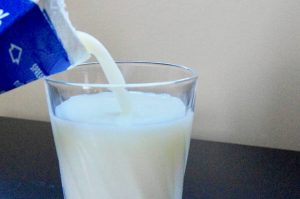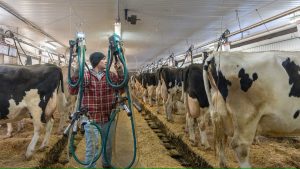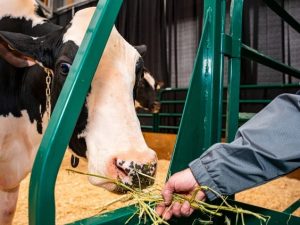
Are beef-on-dairy calf prices suffering because of their ear tags compared to what beef calves fetch at auction?
Western Canada’s dairy producers are taking a pass on a study to see if their industry-required ear tags are disadvantaging beef-cross calves at market.
The now cancelled study hoped to examine whether beef-on-dairy calves, which are given white DairyTrace tags even if they’re bound for beef, would draw lower prices than calves with yellow beef tags.
The project, developed by University of Saskatchewan researchers for delivery by Alberta, Saskatchewan and Manitoba’s milk boards, hoped to draw data from at least 36 farms across the Prairies. As the Dec. 1 deadline passed, there was little uptake.
In early December, Alberta Milk researcher and project lead Kira Hames said cancellation of the project would “likely indicate to us as the industry that it’s not enough of an issue for the majority of our producers to participate and put in the extra time.”
By Dec. 13, organizers had pulled the pin.
Why it matters: Beef-on-dairy diversifies a dairy farm’s revenue by reserving only top animals to birth herd replacements. Less productive milkers are bred to beef and their calves are raised for the meat market.
Beef-on-dairy is increasingly popular with dairy producers. As well as digging out space in a new market, beef-on-dairy crosses yield more and are relatively inexpensive to grow compared to straight dairy calves.
Beef genetics often bring lower maintenance energy costs and feed efficiency. They require fewer days to finish and produce greater retail meat yield. Meat from crosses still grades well and consistency is valued by feedlots.
However, the traceability systems for dairy and beef don’t always mix properly. Beef cattle have yellow radio-frequency identification ear tags through the Canadian Cattle Identification Agency.
DairyTrace, Canada’s national traceability program for the industry, uses white tags. With the exception of Quebec, those tags are the official traceability tool for all Canadian dairy operations.
Last year, DairyTrace’s ear tag policies changed. Producers used to have an exception enabling them put yellow button tags on newborn beef-on-dairy calves instead of white DairyTrace tags.
As of Sept. 1 2023, however, all calves born on dairy farms had to have a DairyTrace tag, including those with beef sires. The same change did away with producers’s ability to replace lost tags on cull cows with a yellow button.
System limits
Both CCIA and DairyTrace systems “have information recorded and there is some ability to transfer the information between the two, but essentially, there are some communication issues at the national level between the two programs,” Hames said.
The two-tag system also doesn’t account for crossbreeds, and the white tags risk buyers mistaking beef-on-dairy genetics with lower-value dairy calves.
“Historically, pure Holstein dairy calves are sold for less to slaughter, primarily because they don’t grow as well (as beef calves). They don’t feed as well. They tend to have longer carcasses, which holds up the slaughter line,” said Hames.
“However, now that we have this beef-on-dairy cross animal, the feed-to-gain ratio is way better for these animals, so they are able to grow quite quickly, similar to beef. They’re better carcass quality. They’re better growers. (Producers) should get more money for these crosses than they do for their pure dairy animals.”
One Eastern Canada study by Lactanet did find price differences between white- and yellow-tagged animals, although Hames noted that study did not give special consideration for beef-0n-dairy calf market performance.
“They did collect data, but we had decided that a more in-depth investigation was needed to truly compare if we’re getting price differences for these crosses with either a yellow or white tag,” she said.
Mountain or molehill?
Hames said they embarked on the project after hearing producer concerns on the issue, despite the following lack of volunteers.
At the same time, she said she has heard feedback from producers who don’t think there’s a significant price difference between beef-tagged calves and beef-on-dairy crossbreeds.
“They’re really happy with the price they’re getting from their buyers,” she noted. “The market’s been really, really good for beef-on-dairy right now. Buyers want their animals.”
Some of the disinterest may stem from dairy producers keeping those crosses, backgrounding them and selling directly to customers, bypassing the auction circuit, she added.
Derek Westeringh, a dairy producer from Warman, Sask., near Saskatoon, says market bias against beef-on-dairy calves is a problem. While he sells direct, other producers have said their white-tagged calves get 10 to 15 per cent less than their beef-tagged counterparts.
He and others who run crossbred cattle hope to get DairyTrace to reverse the 2023 changes.
“We’ve addressed this with our boards and we’re really hoping to get this issue or this mandate reversed by the ProAction committee,” he said.
The ProAction program is mandatory for all Canadian dairy farms and was developed to verify the quality and safety of Canadian milk and the health and welfare of dairy animals, among other points of sustainability.
Beef-on-dairy is financially important to a growing number of Canadian farmers, Westeringh noted.
He pointed to trade concessions in deals like the Comprehensive Economic and Trade Agreement that led to introduction of a federal bill, Bill C-282, that would shield supply managed sectors from future trade concessions. As of Dec.12, that bill was in the report stage before the Canadian Senate.
“There’s been no growth,” Westeringh said, adding that dairy prices have not kept up with the cost of living, and beef-on-dairy has provided a valuable revenue stream.
He would like to see more collaboration between beef and dairy traceability programs, “rather than trying to create two different systems.”
You can now read the most important #news on #eDairyNews #Whatsapp channels!!!
🇺🇸 eDairy News INGLÊS: https://whatsapp.com/channel/0029VaKsjzGDTkJyIN6hcP1K

























